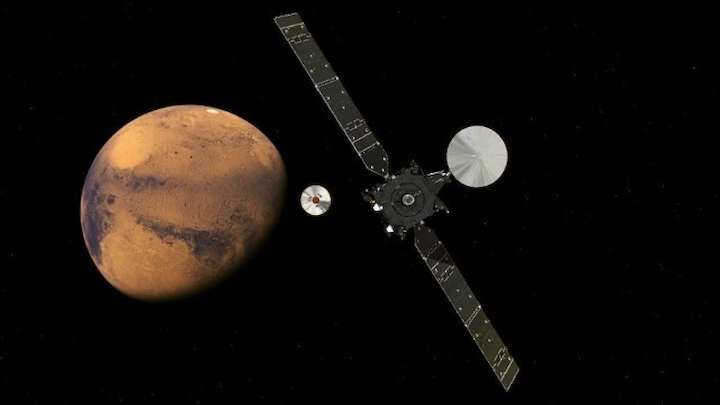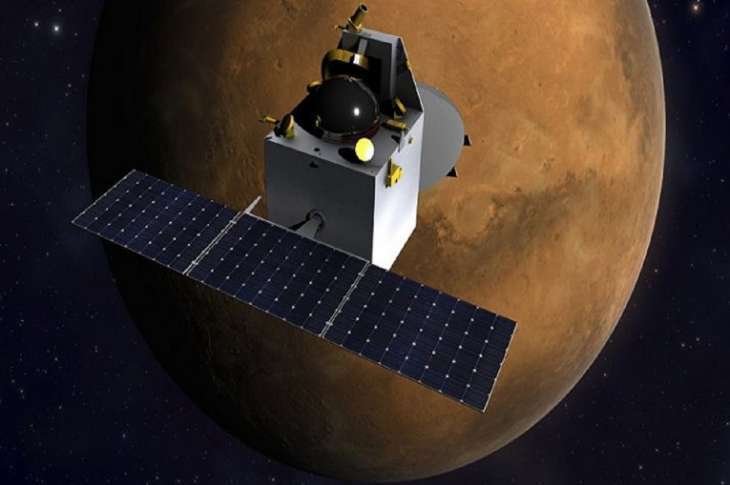13.10.2019
The Mars Orbiter Mission was launched on November 5, 2013
Mangalyaan: Mars orbiter completes 5 years in space, ISRO releases fourth year data

The Mars Orbiter Mission, also known as 'Mangalyaan', a space probe orbiting Mars, completed five years in its orbit on September 24, 2019, Indian Space Research Organisation (ISRO) informed in a tweet on Friday.
ISRO also published 'fourth year data' of Mars Orbiter Mission at ISSDC website for registered users.
"Mars Orbiter Mission has completed five years in its orbit on September 24, 2019. In view of this, the fourth year data (September 24, 2017, to September 23, 2018) of MOM are made available at ISSDC website to registered users," ISRO tweeted.
The Mars Orbiter Mission was launched on November 5, 2013. Mangalyaan had entered Mars orbit on September 24, 2014, after travelling for over 10 months to cover the distance of 666 million km to reach the destination.
It is equipped with five instruments, including a sensor to track methane or marsh gas, a colour camera, and a thermal imaging spectrometer to map the surface and mineral wealth of the red planet. MOM was also adjudged one of the 25 innovations made in 2014 by 'TIME' magazine, which described it as a technological feat that will allow India to flex its "interplanetary muscles."
In its experience of orbiting the Mars for five years, the Mars Orbiter achieved stunning feats- The 1,350kg weighing (on Earth) craft had taken pictures one of the two Martian moons -- Phobos, while it was travelling west to east over Mars in its typical orbit, took pictures of regional dust storm activities over northern hemisphere of Mars, full disc image of the planet, showing Elysium - the second largest volcanic province on the natural satellite.
The 'Mangalyaan' mission made India the first country in the world to successfully launch its mission to Mars on the very first try. Mangalyaan cost Rs 450 crore making it the cheapest inter-planetary mission ever. It was completed in just 15 months.
Quelle: DNA
----
Update: 28.09.2021
.
ISRO'S MARS ORBITER WAS MADE FOR MISSION LIFE OF SIX MONTHS, COMPLETED SEVEN YEARS IN ORBIT THIS MONTH

India's Mars Orbiter spacecraft has completed seven years in its orbit, well beyond its designed mission life of six months.
"Indeed, a satisfying feeling," K Radhakrishnan who as the then Chairman of Indian Space Research Organisation (ISRO) led the Mars Orbiter Mission (Mangalyaan) team told PTI on the milestone.
MOM is the maiden interplanetary mission of ISRO. Launched on November 5, 2013, the probe was successfully inserted into Martian orbit on 24 September 2014 in its first attempt.
MOM is primarily a technology demonstration venture and all the mission objectives were successfully met, according to officials of Bengaluru-headquartered India's national space agency.
The main lessons learnt were in the field of design and realisation of systems and subsystems, launch for interplanetary mission, insertion into other planet's orbit, operation of the spacecraft and scientific instruments around Mars orbit, they said.
The lessons learnt have raised the confidence of ISRO scientists for taking up future interplanetary missions.
ISRO has been continuously monitoring the spacecraft and its five scientific instruments, and officials said scientific analysis of the data being received from MOM spacecraft is in progress.
On the health of the spacecraft, M Annadurai, who was the Programme Director of MOM, said the spacecraft's "moving elements are facing some issues and some of the redundancies we have to switch over." "The spacecraft's health is reasonably good considering that we are in the seventh year," Annadurai told PTI.
He expects the spacecraft to have a mission life of probably another one year.
On the reasons for the long mission life, Annadurai said ISRO had done corrections after learning lessons from the Chandrayaan-1 venture, in terms of reconfiguring the spacecraft and optimisation of fuel management, among others.
Noting that Earth remote-sensing satellites typically have a mission life of seven to nine years, he said it was a very satisfying moment that India could establish that around Mars also, a spacecraft can be in operation for such a long period.
On some criticism in some quarters that scientific output of the MOM was "low", Annadurai said it was more of a technology-demonstration mission.
He pointed out that the spacecraft was launched by PSLV as GSLV was not in operational condition then. ISRO could apportion only about 15 kg for scientific instruments, and the time available for scientists to develop them was only 18-19 months.
"I don't think we could have done better than what we have done," Annadurai said.
ISRO officials said the spacecraft has already covered three Martian years (one Martian year is about two earth years).
"We have seen how changes happen on the Mars from one season to another, one Martian year to another Martian year," they said.
Annadurai said: "We have good inputs on seasonal affects on Mars atmosphere...surface. The mission has provided meaningful data also".
Quelle: TECH2
----
Update: 3.10.2022
.
India's maiden mars mission Mangalyaan quietly bids adieu: Orbiter runs out of fuel
Mangalyaan - the Rs 450 crore Mars Orbiter Mission was launched onboard PSLV-C25 on November five, 2013, and the MOM spacecraft was successfully inserted into Martian orbit on September 24, 2014 in its first attempt.

India's maiden Mars Orbiter craft reportedly ran out of propellant and its battery drained beyond the safe limit, fuelling speculation that the country's interplanetary mission 'Mangalyaan' may have finally completed its 8-year long innings.
The Rs 450 crore Mars Orbiter Mission was launched onboard PSLV-C25 on November five, 2013, and the MOM spacecraft was successfully inserted into Martian orbit on September 24, 2014 in its first attempt. "Right now, there is no fuel left. The satellite battery has drained," sources in the Indian Space Research Organisation (ISRO) told PTI. "The link has been lost".
There was, however, no official word from the country's national space agency, headquartered here.
With fuel on board, ISRO had been performing orbital manoeuvres on MOM spacecraft to take it to a new orbit to avoid an impending eclipse in the past.
"But recently there were back-to-back eclipses including one that lasted seven-and-half hours," officials said on condition of anonymity, noting that all the propellant on board the ageing satellite had been consumed.
"As the satellite battery is designed to handle eclipse duration of only about one hour and 40 minutes, a longer eclipse would drain the battery beyond the safe limit," another official said. ISRO officials noted that the Mars orbiter craft functioned for almost eight years, well beyond its designed mission life of six months.
"It has done its job and yielded significant scientific results," they said.
The objectives of the mission were primarily technological and included design, realisation and launch of a Mars Orbiter spacecraft capable of operating with sufficient autonomy during the journey phase; Mars orbit insertion/ capture and in-orbit phase around Mars.
The MOM -- a technology demonstration venture -- carried five scientific payloads (total 15 kg) collecting data on surface geology, morphology, atmospheric processes, surface temperature and atmospheric escape process.
The five instruments are: Mars Color Camera (MCC), Thermal Infrared Imaging Spectrometer (TIS), Methane Sensor for Mars (MSM), Mars Exospheric Neutral Composition Analyser (MENCA) and Lyman Alpha Photometer (LAP).
"MOM is credited with many laurels like cost-effectiveness, short period of realisation, economical mass-budget, and miniaturisation of five heterogeneous science payloads", ISRO officials pointed out.
Highly elliptical orbit geometry of MOM enabled MCC to take snap shots of 'Full disc' of Mars at its farthest point and finer details from closest point.
The MCC has produced more than 1000 images and published a Mars Atlas.
Meanwhile, plans on a follow-on 'Mangalyaan' mission to the red planet, however, are yet to be firmed up.
ISRO came out with an 'Announcement of Opportunity' (AO) for future Mars Orbiter Mission (MOM-2) in 2016 but officials acknowledged that it's still on the drawing board, with the coming 'Gaganyaan', 'Chandrayaan-3' and 'Aditya - L1' projects being in the space agency's current priority list.
The AO had said: "It is now planned to have the next orbiter mission around Mars for a future launch opportunity. Proposals are solicited from interested scientists within India for experiments onboard an orbiter mission around Mars (MOM-2), to address relevant scientific problems and topics."
"Not in the approved list as of now", a senior ISRO official told PTI on being asked about an update on the MOM-2.
"We need to formulate the project proposals and payloads based on the wider consultation with the research community," the official said. "It's still on the drawing board. But needs some more details and international collaboration for finalising the mission."
Quelle: INDIA TV
